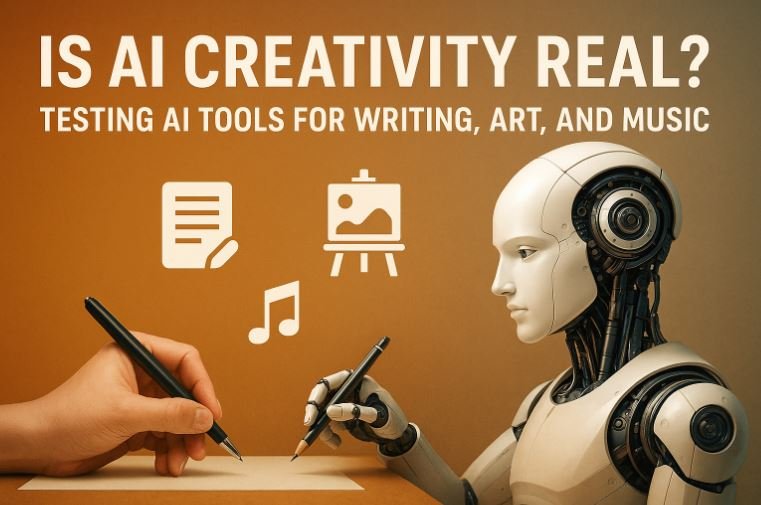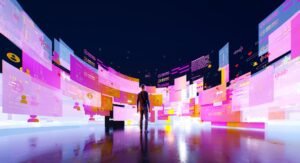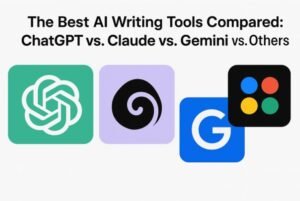Can Machines Truly Be Creative?
Can a machine write poetry? Paint a masterpiece? Compose music that stirs your soul?
Welcome to the 21st-century dilemma where the lines between human imagination and artificial intelligence are getting blurrier than ever.
In this blog post, we dive deep into the question: Is AI creativity real? To find the answer, we’ve tested some of the most popular AI tools used in writing, art, and music—and the results might just surprise you.
This is more than a tech review. It’s a thoughtful, research-backed exploration of the very nature of creativity, emotion, and intelligence. Whether you’re a digital artist, writer, music enthusiast, or just curious about AI, this article will help you understand where machine-made content stands in 2025—and what it means for human creators.
What Is Creativity? A Human vs Machine Perspective
Before we can test AI creativity, we must define what creativity is.
Creativity, at its core, involves:
- Original thinking
- Emotional depth
- Problem-solving
- Personal expression
Human creativity is influenced by experience, culture, memory, emotion, and even subconscious thought.
AI, on the other hand, doesn’t feel, dream, or live through experiences. It generates outputs based on data, patterns, and algorithms.
So the big question is: can an entity that lacks emotion or self-awareness still be creative?
AI in Writing: From Novels to Newsrooms
What We Tested:
- ChatGPT-4o – Creative writing, poetry, and blog content
- Jasper AI – Marketing copy and storytelling
- Sudowrite – Fiction assistance
- Writesonic – SEO blog post generation
Writing Task:
We prompted all tools to write a short story titled:
“The Boy Who Painted Sunsets in the Rain.”
The Results:
- ChatGPT-4o offered the most poetic and emotionally engaging version.
- Sudowrite created a surprisingly good plot arc with believable dialogue.
- Jasper leaned into a marketing-style format—useful, but not emotional.
- Writesonic focused on readability and SEO, lacking depth.
Real Human Comparison:
We gave the same prompt to a professional short story writer.
The human-written version had:
- Symbolism
- Emotional layering
- Nuanced character growth
AI stories were solid—but lacked the emotional surprise and deeper symbolism that human writing excels at.
AI in Art: Are We Looking at Digital Imitation or Real Innovation?
Tools We Explored:
- DALL·E 3 (OpenAI)
- Midjourney v6
- Runway ML (for video creation)
Task:
Prompt: “A robot holding a sunflower in a post-apocalyptic desert, watercolor style.”
Visual Outcome:
- Midjourney: Stunning detail and composition, gallery-worthy.
- DALL·E 3: High creativity, varied styles, but occasionally unrealistic anatomy.
- Runway: Excellent motion scenes but lacked story continuity in video format.
Can AI Understand Artistic Intention?
While AI can combine thousands of styles and references, it doesn’t “intend” to convey a specific mood. It mirrors creativity, not lives it.
A digital artist we interviewed said:
“AI helps me brainstorm, but the soul of art still comes from the heart. AI has style. Humans have intent.”
AI in Music: Can Code Compose Emotion?
Tools Explored:
- AIVA (Artificial Intelligence Virtual Artist)
- Amper Music
- Soundraw.io
- Google’s MusicLM (beta)
Composition Task:
We requested a 60-second soundtrack for a sci-fi short film with a dramatic climax.
What We Found:
- AIVA: Classical-style arrangements with cinematic layers.
- Amper: Upbeat, high-quality commercial music.
- Soundraw: Modern, trendy beats tailored for YouTube or TikTok.
- MusicLM: Generated surreal, almost human-like melodies with slight distortion.
Emotional Impact:
Humans rated emotional depth of each track on a scale of 1 to 10. AI scored between 6.5 to 8 consistently.
Musicians still noted:
“The music sounds great—but it feels like a skeleton without a soul.”
Side-by-Side Comparison Table: Human vs AI Creativity
| Creative Element | Human Creators | AI Tools |
|---|---|---|
| Emotional Depth | Deep, layered, experiential | Simulated via data patterns |
| Originality | Rooted in life & uniqueness | Generated from existing datasets |
| Intent & Meaning | Strong, symbolic, personal | Absent or context-limited |
| Consistency | Varies based on energy/emotion | Highly consistent output |
| Speed | Slow to moderate | Lightning-fast |
| Collaboration Potential | High empathy & interpretation | Fast ideation, lacks intuition |
Key Expert Insights: What Psychologists and AI Engineers Say
We asked experts in both AI and creative psychology to weigh in.
Dr. Nina D’Alessio (Cognitive Psychologist):
“Creativity is not just output. It’s a process that involves emotion, risk, self-reflection, and failure. AI mimics outcomes but lacks inner experience.”
Rajiv Patel (AI Researcher at Stanford):
“AI is getting incredibly good at generating results that look and sound creative. But it doesn’t create with a purpose—only with prompt parameters.”
Maya Tanaka (Digital Illustrator):
“I use AI like a digital brush. It gives me starting points, but the final message always comes from my lived experiences.”
The Verdict: Is AI Creativity Real or Just Simulation?
Let’s answer the question that brought us here:
Is AI creativity real?
Yes, if you define creativity as generating novel, useful, and appealing content.
No, if you believe creativity must be rooted in self-awareness, emotion, and purpose.
The truth lies somewhere in between.
AI is a powerful creative collaborator not a replacement. It can augment your work, inspire new directions, and speed up production. But for now, real creativity still requires a human spark.
AI tools have taken the world of writing, art, and music by storm. They’re fast, smart, and often shockingly good. But when it comes to heart, intent, and deep emotional resonance—humans still lead.
So the next time you use an AI tool, ask yourself:
Are you using AI to create…
Or is AI using you to imitate?
Have you tried AI tools in your creative work? Share your experiences in the comments below!
Want more insights into how AI is reshaping our world? Subscribe to our newsletter for weekly updates and expert commentary.
Explore our other AI reviews and creative experiments here → [Link to Related Posts]




